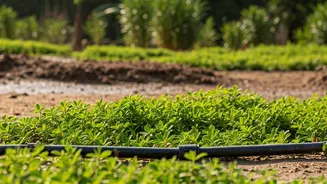Plant Selection Matters
The cornerstone of a climate-resilient garden lies in choosing plants that are well-suited to the Indian climate. Prioritize native species, as they have
naturally adapted to the local environment and are generally more drought-tolerant and disease-resistant. Consider the microclimates within your garden; areas exposed to direct sunlight require different plants compared to shaded spots. Assess the soil conditions as well. Select plants that can thrive in your soil type, whether it is sandy, loamy, or clay-rich. Group plants with similar water requirements together to optimize irrigation. By thoughtfully selecting plants, you establish the foundation for a garden that not only survives but flourishes in the Indian climate. Research and choose plants that contribute to biodiversity, supporting local pollinators and beneficial insects, which further strengthen the ecosystem within your garden.
Efficient Water Management
Effective water management is crucial for a climate-resilient garden in India, where water scarcity is a significant concern. Implement water-saving irrigation techniques, such as drip irrigation or soaker hoses, to deliver water directly to the plant roots, minimizing water loss through evaporation. Mulching with organic materials like straw, wood chips, or shredded leaves helps retain soil moisture, reducing the need for frequent watering. Consider creating a rainwater harvesting system to collect and store rainwater, which can be used to irrigate your garden during dry periods. Grouping plants with similar water needs helps optimize water usage; drought-tolerant plants should be placed together and watered less frequently. Regularly monitor your garden for signs of overwatering or underwatering, adjusting your irrigation schedule as needed. By implementing these practices, you can conserve water and sustain your garden throughout the changing seasons.
Soil Health & Care
Healthy soil is the lifeblood of a thriving garden, and nurturing the soil is fundamental to climate resilience. Begin by conducting a soil test to understand its composition, pH level, and nutrient content. Amend the soil with organic matter, such as compost or well-rotted manure, to improve its structure, water retention capacity, and fertility. Organic matter also enriches the soil with beneficial microorganisms that support plant health. Practice no-till gardening to minimize soil disturbance and preserve the existing soil structure. Cover cropping, or planting cover crops between your main crops, can protect the soil from erosion, suppress weeds, and add nutrients. Regularly add compost to your garden to replenish the nutrients. The inclusion of compost is also essential for improving soil's ability to retain moisture. By focusing on soil health, you can create a garden that is better equipped to withstand climate challenges and produce healthy, vigorous plants.
Sustainable Practices
Embracing sustainable gardening practices contributes significantly to climate resilience and environmental stewardship. Avoid the use of synthetic fertilizers and pesticides, which can harm the soil, water resources, and beneficial insects. Instead, opt for organic alternatives, such as compost tea, neem oil, or beneficial insects, to control pests and diseases. Practice composting to reduce waste and create nutrient-rich soil amendments. Conserve resources by reusing materials whenever possible, such as pots, tools, and irrigation equipment. Incorporate companion planting to take advantage of natural pest control and nutrient cycling. Encourage biodiversity in your garden by planting a variety of plants to attract pollinators and beneficial insects. By adopting these sustainable practices, you create a garden that is not only resilient but also environmentally friendly and contributes to a healthier ecosystem.
Seasonal Considerations
Adapting your gardening practices to the different seasons in India is essential for maintaining a climate-resilient garden. In the summer, provide shade to heat-sensitive plants and water them more frequently. Mulch heavily to retain soil moisture and reduce water loss. During the monsoon season, ensure proper drainage to prevent waterlogging. Protect plants from heavy rainfall and strong winds. In the winter, protect plants from frost by covering them or relocating them indoors if necessary. Adjust your watering schedule based on the weather conditions. Plan your planting schedule according to the seasonal variations in temperature and rainfall. Select plants that are suitable for each season and can thrive in the prevailing conditions. By understanding and adapting to the seasonal changes, you can ensure that your garden remains healthy and productive year-round, despite the challenges posed by the climate.


















